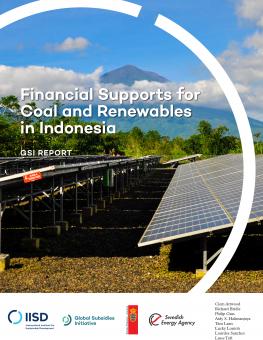
Financial Supports for Coal and Renewables in Indonesia
This report shows that the “true cost” of coal, including subsidies and externalities such as GHG emissions and air pollution, is considerably greater than the cost of renewable energy in Indonesia.
Electricity generation remains a key issue for Indonesian policy-makers. Millions of households are still without access to electricity, and large investments are needed to supply reliable power for households and industries across the country.
Coal has become an increasingly central part of Indonesia’s power plans and is expected by the government to continue to play a significant role in the decades to come. In 2014, coal accounted for 31 per cent of Indonesia’s primary energy mix, up from 17 per cent in 2004. In 2025, the government expects coal to meet around 30 per cent of Indonesia’s primary energy demand. In 2050, projections estimate coal to account for 25 per cent of Indonesia’s primary energy mix.
While this would see the total share of coal in the energy mix decline slightly, the projected growth in total energy consumption implies a large expansion in coal power production. This is also reflected in the government’s near-term plans to rapidly expand power production by 35 gigawatts (GW), with more than 20 GW of this amount to come from coal.
Nevertheless, concerns over the environmental impact of coal use and a desire to expand access to energy as quickly and cost-effectively as possible have created pressure to adopt cleaner forms of energy production.
Despite its negative impact, Indonesia’s coal industry and electricity sector have access to subsidies that can lock in coal use for the coming decades. By contrast, renewable energy is often perceived as too expensive to build on a large scale. However, such opinions are usually not based on an assessment of the true costs of generating electricity from renewables, which can be competitive with or even lower than coal. This is especially true when taking account of negative externalities such as air pollution and greenhouse gas emissions.
This report provides an estimate of subsidies to coal and renewables in Indonesia. It also considers the cost of externalities in order to make a comparison of the true costs associated with electricity generation from coal and renewable energy respectively.
Additional downloads
You might also be interested in
What the war in Ukraine means for Asia's climate goals
The queues outside petrol pumps in Sri Lanka have lessened, but not the anxiety. Asanka Sampath, a 43-year-old factory clerk, is forever vigilant. He checks his phone for messages, walks past the pump, and browses social media to see if fuel has arrived. Delays could mean being left stranded for days. "I am really fed up with this," he said. His frustrations echo that of the 22-million inhabitants of the island nation, facing its worst ever economic crisis because of heavy debts, lost tourism revenue during the pandemic, and surging costs. The consequent political turmoil culminated with the formation of a new government, but recovery has been complicated by Russia's invasion of Ukraine, and the consequent upending of global energy markets.
Curbing fuel subsidies is only the first step out of energy crisis
Indonesia’s fuel subsidies have been a recurring problem for the country’s economy. For years, they have been weighing on the state budget, providing unjust support for fossil fuels and slowing the much-awaited clean energy transition. But skyrocketing global energy prices could require the country to allocate a colossal Rp 700 trillion (US$46.6 billion) for energy subsidies this year – more than four times the budgeted amount.
Switching Fossil Fuel Subsidies in Indonesia to Support a Green Recovery
This brief looks at how Indonesia can start actively promoting renewable energy by removing the existing hurdles to its deployment—such as unattractive renewable energy feed-in tariffs and land and infrastructures barriers—and switching public support from fossil fuels to renewables to meet the country’s clean energy targets.
Indonesia's fiscal support for fossil fuels too large: IISD
The Indonesian government's fiscal support for fossil fuels is still too large, so it has the potential to slow down the energy transition and drain the public budget, according to the International Institute for Sustainable Development (IISD).